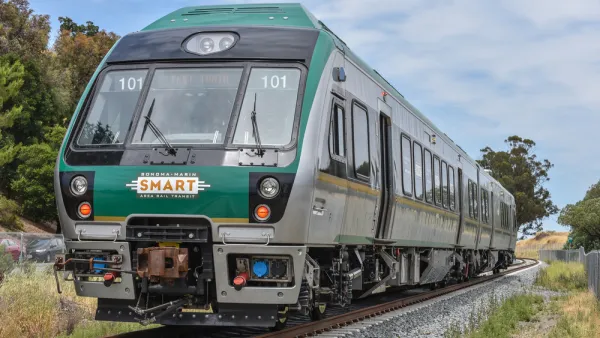State rail officials decided that the risk posed by Sonoma Marin Area Rail Transit trains is too grave to allow an existing grade crossing to remain open, forcing pedestrians and a cyclists out of their way to cross the tracks.
In California, the "California Public Utilities Commission (CPUC) staff ensure that highway-rail crossings are safely designed, constructed, and maintained." Some would say they take that commitment to extremes. Case in point: a Santa Rosa pedestrian grade crossing.
On November 4, the CPUC "ordered Santa Rosa and the Sonoma-Marin Area Rail Transit (SMART) agency to take steps to prevent people from crossing the tracks [at Jennings Ave (map)], a popular but unauthorized access route and potentially dangerous point of conflict between trains and schoolchildren," writes Kevin Mccallum of The Press Democrat.
Unlike a September post on a Union Pacific Railroad grade crossing in Houston which indicated that "(t)he solution is to build overpasses or underpasses in as many places as possible," neither is possible at this location according to the Santa Rosa City Council, though the city received a $8.2 million grant for a pedestrian bridge.
Instead, "(t)he city is hoping to convince the state Public Utilities Commission to allow it to build a formal crossing, complete with flashing lights and crossing gates, at that location before rail service begins in late 2016," writes Mccallum.
An artist's rendering depicts a pedestrian and bicycle crossing Santa Rosa plans to pursue at Jennings Avenue.
That request has been met with skepticism by PUC rail safety staff, who argue that it is safer to have fewer at-grade rail crossings because it limits potential collisions between trains and cars, bicycles and pedestrians.
Meanwhile, a 6-foot tall fence is being installed to close the informal crossing from East Jennings Ave. to West Jennings Ave., forcing "residents of the neighborhood east of the tracks, including students at Helen M. Lehman Elementary School, to walk or ride about a quarter-mile north along a dirt access road to Guerneville Road, cross the tracks and walk a quarter-mile back down North Dutton Avenue.," writes Mccallum. See the city's "recommended alternate route for Jennings Avenue east-west connection."
Note the irony - students still cross the tracks at grade—adjacent to heavy vehicular traffic. More irony: a selling point for the 2008 ballot measure authorizing the rail line was the pedestrian-bicycle pathway that would parallel the 70-mile rail line from Cloverdale to San Rafael.
The PUC would allow Jennings Avenue to be properly designed for an at-grade crossing—but only if the city agreed to close another grade crossing. The city argues that because it is limited to pedestrians and cyclists, it should be exempt from that requirement.
Expect a resolution by an administrative judge in the spring. In the meanwhile, residents lose the shortcut which the city argues will do three things, according to Mccallum:
- Put more children in danger along the heavily trafficked Guerneville Road;
- put more cars on the road as parents decide to drive kids to school;
- and prompt people to cut the fence and cross anyway.
Elsewhere on the SMART line, railway officials "approved a $1.4 million contract Wednesday for engineering work on the 2.2-mile segment" to the Larkspur Ferry Landing where passengers would transfer to a ferry to San Francisco, writes Mark Prado for the Marin Independent Journal in an update on the rail line. It is uncertain whether they will receive the $20 million in a federal small starts grant they applied for.
Rail service on Phase One from Sonoma County Airport to San Rafael [map] is expected to begin in late 2016.
Hat tip to Adrian Brandt.
FULL STORY: State PUC orders Santa Rosa, SMART to block risky rail crossings at Jennings Avenue

National Parks Layoffs Will Cause Communities to Lose Billions
Thousands of essential park workers were laid off this week, just before the busy spring break season.

Retro-silient?: America’s First “Eco-burb,” The Woodlands Turns 50
A master-planned community north of Houston offers lessons on green infrastructure and resilient design, but falls short of its founder’s lofty affordability and walkability goals.

Delivering for America Plan Will Downgrade Mail Service in at Least 49.5 Percent of Zip Codes
Republican and Democrat lawmakers criticize the plan for its disproportionate negative impact on rural communities.

Test News Post 1
This is a summary

Test News Headline 46
Test for the image on the front page.

Balancing Bombs and Butterflies: How the National Guard Protects a Rare Species
The National Guard at Fort Indiantown Gap uses GIS technology and land management strategies to balance military training with conservation efforts, ensuring the survival of the rare eastern regal fritillary butterfly.
Urban Design for Planners 1: Software Tools
This six-course series explores essential urban design concepts using open source software and equips planners with the tools they need to participate fully in the urban design process.
Planning for Universal Design
Learn the tools for implementing Universal Design in planning regulations.
EMC Planning Group, Inc.
Planetizen
Planetizen
Mpact (formerly Rail~Volution)
Great Falls Development Authority, Inc.
HUDs Office of Policy Development and Research
NYU Wagner Graduate School of Public Service




























